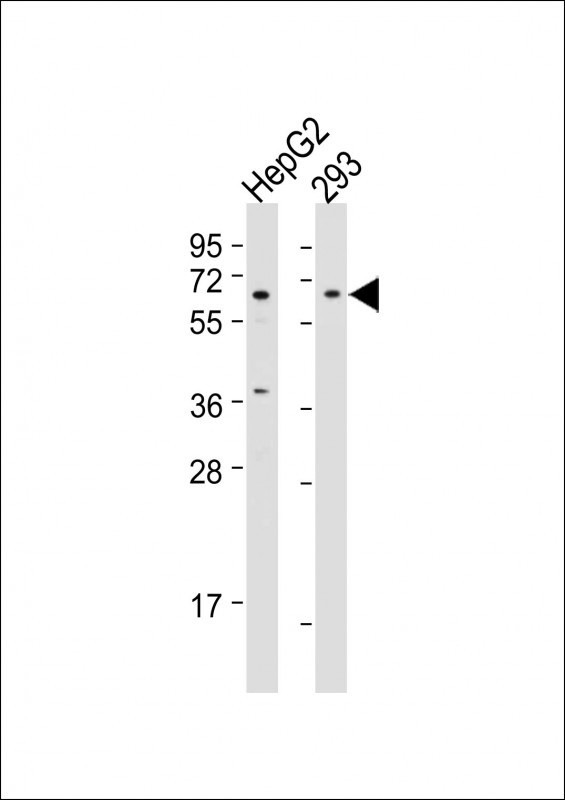
| WB | 咨询技术 | Human,Mouse,Rat |
| IF | 咨询技术 | Human,Mouse,Rat |
| IHC | 咨询技术 | Human,Mouse,Rat |
| ICC | 技术咨询 | Human,Mouse,Rat |
| FCM | 咨询技术 | Human,Mouse,Rat |
| Elisa | 咨询技术 | Human,Mouse,Rat |
| Aliases | F-box/WD repeat-containing protein 1A, E3RSIkappaB, Epididymis tissue protein Li 2a, F-box and WD repeats protein beta-TrCP, pIkappaBalpha-E3 receptor subunit, BTRC, BTRCP, FBW1A, FBXW1A |
| Entrez GeneID | 8945 |
| WB Predicted band size | 68.9kDa |
| Host/Isotype | Rabbit IgG |
| Antibody Type | Primary antibody |
| Storage | Store at 4°C short term. Aliquot and store at -20°C long term. Avoid freeze/thaw cycles. |
| Species Reactivity | Human, Mouse |
| Immunogen | This BTRC antibody is generated from rabbits immunized with a KLH conjugated synthetic peptide between 17-52 amino acids from the N-terminal region of human BTRC. |
| Formulation | Purified antibody in PBS with 0.05% sodium azide. |
+ +
以下是关于BTRC(β-TrCP,N-term)抗体的3篇参考文献及其摘要概括:
---
1. **文献名称**:*"β-TrCP-mediated ubiquitination and degradation of IκBα: A critical step in NF-κB activation"*
**作者**:Yaron, A., et al.
**摘要**:该研究揭示了β-TrCP通过识别磷酸化的IκBα并介导其泛素化降解,从而激活NF-κB信号通路的机制。研究中使用了针对β-TrCP N端结构域的特异性抗体,通过免疫共沉淀(Co-IP)验证了β-TrCP与IκBα的相互作用,并证实抗体在Western blot中的特异性。
---
2. **文献名称**:*"Development of a monoclonal antibody specific for the N-terminal region of β-TrCP1 for cancer biomarker studies"*
**作者**:Suzuki, H., et al.
**摘要**:本研究开发了一种靶向β-TrCP1蛋白N端表位的单克隆抗体,并验证了其在结直肠癌组织中的表达检测能力。抗体通过ELISA和免疫组化(IHC)验证了高亲和力和特异性,结果显示β-TrCP1在肿瘤组织中过表达,提示其作为潜在生物标志物的可能性。
---
3. **文献名称**:*"β-TrCP-dependent degradation of Emi1 regulates the G2/M transition in mitosis"*
**作者**:Margottin-Goguet, F., et al.
**摘要**:该研究阐明了β-TrCP通过泛素化降解细胞周期调控蛋白Emi1.促进有丝分裂进程的机制。实验中采用N端特异性β-TrCP抗体进行免疫荧光染色,证实了β-TrCP在细胞周期G2/M期的亚细胞定位变化,并验证了抗体在活细胞成像中的可靠性。
---
以上文献均聚焦于β-TrCP的N端抗体在信号通路、癌症研究及细胞周期调控中的应用,涵盖了抗体开发、功能验证及具体生物学问题的探索。
The BTRC (Beta-Transducin Repeat Containing) antibody, specifically targeting the N-terminal region of the BTRC protein (also known as β-TrCP1), is a key tool for studying ubiquitin-mediated protein degradation. BTRC is an F-box protein within the SCF (Skp1-Cullin-F-box) E3 ubiquitin ligase complex, responsible for recognizing phosphorylated substrates and marking them for proteasomal degradation. It regulates critical cellular processes, including cell cycle progression, DNA damage response, and NF-κB signaling, by targeting proteins like IκB, β-catenin, and CDC25 for degradation.
The N-terminal domain of BTRC is essential for substrate binding, particularly through interactions with phosphorylated degron motifs. Antibodies against this region are widely used to detect BTRC expression, localization, and interaction partners in techniques such as Western blotting, immunoprecipitation, and immunofluorescence. Their specificity helps differentiate BTRC from its homolog β-TrCP2 (FBXW11), which shares functional overlap but has distinct substrate preferences.
Research utilizing BTRC (N-term) antibodies has advanced understanding of diseases linked to dysregulated protein turnover, including cancer, neurodegenerative disorders, and immune dysregulation. For example, BTRC overexpression in certain cancers promotes oncoprotein stability, while its inhibition can sensitize cells to therapies. These antibodies also aid in exploring BTRC's role in viral infections, where pathogens exploit the ubiquitin-proteasome system. Overall, they are indispensable for dissecting the complexity of ubiquitin-dependent signaling networks.
×